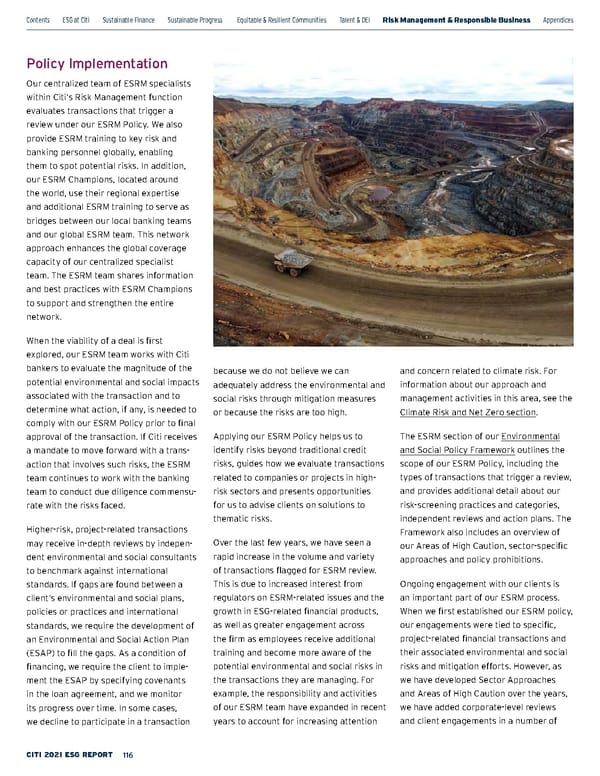Policy Implementation Our centralized team of ESRM specialists within Citi’s Risk Management function evaluates transactions that trigger a review under our ESRM Policy. We also provide ESRM training to key risk and banking personnel globally, enabling them to spot potential risks. In addition, our ESRM Champions, located around the world, use their regional expertise and additional ESRM training to serve as bridges between our local banking teams and our global ESRM team. This network approach enhances the global coverage capacity of our centralized specialist team. The ESRM team shares information and best practices with ESRM Champions to support and strengthen the entire network. When the viability of a deal is first explored, our ESRM team works with Citi bankers to evaluate the magnitude of the potential environmental and social impacts associated with the transaction and to determine what action, if any, is needed to comply with our ESRM Policy prior to final approval of the transaction. If Citi receives a mandate to move forward with a trans - action that involves such risks, the ESRM team continues to work with the banking team to conduct due diligence commensu - rate with the risks faced. Higher-risk, p roject-related t ransactions may receive in-depth reviews by indepen - dent environmental and social consultants to benchmark against international standards. If gaps are found between a client’s environmental and social plans, policies or practices and international standards, we require the development of an Environmental and Social Action Plan (ESAP) to fill the gaps. As a condition of financing, we require the client to imple - ment the ESAP by specifying covenants in the loan agreement, and we monitor its progress over time. In some cases, we decline to participate in a transaction because we do not believe we can adequately address the environmental and social risks through mitigation measures or because the risks are too high. Applying our ESRM Policy helps us to identify risks beyond traditional credit risks, guides how we evaluate transactions related to companies or projects in high- risk sectors and presents opportunities for us to advise clients on solutions to thematic risks. Over the last few years, we have seen a rapid increase in the volume and variety of transactions flagged for ESRM review. This is due to increased interest from regulators on ESRM-related issues and the growth in ESG-related financial products, as well as greater engagement across the firm as employees receive additional training and become more aware of the potential environmental and social risks in the transactions they are managing. For example, the responsibility and activities of our ESRM team have expanded in recent years to account for increasing attention and concern related to climate risk. For information about our approach and management activities in this area, see the Climate Risk and Net Zero section . The ESRM section of our Environmental and Social Policy Framework outlines the scope of our ESRM Policy, including the types of transactions that trigger a review, and provides additional detail about our risk-screening practices and categories, independent reviews and action plans. The Framework also includes an overview of our Areas of High Caution, sector-specific approaches and policy prohibitions. Ongoing engagement with our clients is an important part of our ESRM process. When we first established our ESRM policy, our engagements were tied to specific, project-related financial transactions and their associated environmental and social risks and mitigation efforts. However, as we have developed Sector Approaches and Areas of High Caution over the years, we have added corporate-level reviews and client engagements in a number of Contents ESGatCiti SustainableFinance SustainableProgress Equitable&ResilientCommunities Talent&DEI RiskManagement&ResponsibleBusiness Appendices CITI 2021 ESG REPORT 116
 Citi ESG Report Page 115 Page 117
Citi ESG Report Page 115 Page 117